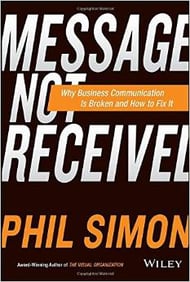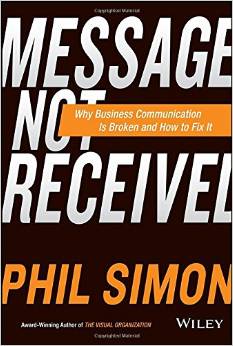Business professionals are drowning in data, and we receive more emails, notifications and requests than ever before. With all this noise demanding our attention, how can we focus on what really matters to our business?
For answers, we turned to Phil Simon (@philsimon), friend, keynote speaker and author of Message Not Received (Wiley, 2015). The new book outlines how professionals and organizations can communicate more effectively and increase efficiency through simpler language and new technologies. Read on for insights on why business communication is broken, and how we can fix it.
Why did you write Message Not Received now?
 That’s a great question. I’ll be the first to admit that many other books address business communication. To boot, jargon has been with us for a very long time. So why write this book now?
That’s a great question. I’ll be the first to admit that many other books address business communication. To boot, jargon has been with us for a very long time. So why write this book now?
I truly believe that we’ve reached a tipping point, and my research confirmed as much. Employees have never been more overwhelmed, the subject of Chapter 2 of my book. They’re being asked to integrate more content, more messages. They’re checking e-mail on weekends, holidays, and vacation (when they take it). They’re constantly on call, barely able to keep their heads above water.
Fortunately, there’s a two-fold solution, and I didn’t see any book out there that attacked this problem from this particular angle. First, we can embrace simpler language. There’s no reason to use terms “value-add use cases” and other linguistic atrocities. Beyond that, everything need not be communicated via e-mail. New, truly collaborative tools like HipChat, Smartsheet, and scores of others make it easier than ever to communicate effectively. And let’s not forget the ability go old school. Sometimes, an in-person meeting or phone conversation is the best way to proceed. Far too many of us seem to have forgotten that.
Is jargon increasing or decreasing as a problem?
As I write in the book it’s on the rise for a bunch of reasons. Perhaps most important, marketers want to “own” individual terms. The race to the top of Google’s organic results has never been fiercer. As a result, consulting firms, software vendors, and marketers are inventing newfangled concepts at a faster clip than ever.
If you doubt the increase in jargon, consider the following. We’re receiving more e-mails than ever. As I’ve written my prior two texts, employees are being forced to deal with more information that ever. Ditto for your everyday consumer. Let’s say that you received 100 e-mails per day in 2000 and 15 percent contained confusing language. You had to follow up with the sender 15 times to get more clarity.
Fast forward to today. You receive 150 e-mails per day and the same percentage confuses you. You now have to go back to the sender more than 20 times and ask for more information. If you don’t, then the sender’s message wasn’t truly received.
Let’s talk about e-mail. Has it always been an ineffective communication channel? Was there a turning point?
It’s not always effective or totally ineffective. Communication has always been contextual. Certain mediums can be better than others. Marshall McLuhan famously said, “The medium is the message.” He’s absolutely right.
I’m not anti-e-mail; I’m anti-inefficiency. Productivity usually suffers on incessant e-mail chains.
Let me make it more concrete. Let’s assume that 80 percent of e-mails are actually clear and you receive 10 e-mails per day. That means two don’t make any sense to you. That’s manageable.
We actually get 120 to 150 e-mails per day. More than 20 times per day, you receive a message that doesn’t make any sense to you.
E-mail was never designed to be a collaboration tool. You can’t search your inbox as effectively as you can search 25 trillion web pages. It usually takes us less than one second on Google to get what we want. Our inboxes contain 20,000 messages. At least a few times per day, we can’t find something in our inbox.
Brass tacks: E-mail should not be our default communication tool.
In your view, what has the impact of talking less (and sending more messages) been on business communication?
In short, it’s not good. We’re sending more messages than ever. Many of us confuse quantity for quality—or consciously don’t bother to make the distinction. Others take a sort of perverse pride in the number of e-mails they receive. It’s as if they’re their self-importance and sense of self vary in direct proportion to the size of their inboxes.
Employees have never been more overwhelmed, and recent research backs up that claim. We rely almost exclusively on e-mail as the default tool for corporate communications. We send five e-mails when a one-minute phone call would suffice. It’s insane. The LexisNexis Workplace Productivity Survey reveals the extent of this problem.
Got any tips for communicating more clearly at work?
First, if at all possible, speak simply. In the words of Albert Einstein, “If you can't explain it simply, you don't understand it well enough.” Vague, buzzword-laden speeches and messages are unlikely to result in true understanding and successful results.
Second, encourage your employees to experiment with new tools. In an era of bring your own device, employees are already communicating with each other in ways not sanctioned by IT departments. The days of tightly locking down all communications are over.
Finally, don’t be afraid to let go of employees who refuse to embrace new ways of work and communicating. Internal wikis and knowledge bases are only as helpful as they data they contain. Project plans quickly become inaccurate when not populated with the most recent updates. Ditto for bad communicators.
 Phil Simon is a recognized technology authority. He is the award-winning author of seven management books, most recently Message Not Received. He consults organizations on matters related to communications, strategy, data, and technology. His contributions have been featured on The Harvard Business Review, CNN, Wired, NBC, CNBC, Inc. Magazine, BusinessWeek, Quartz, The Huffington Post, The New York Times, Fox News, and many other sites.
Phil Simon is a recognized technology authority. He is the award-winning author of seven management books, most recently Message Not Received. He consults organizations on matters related to communications, strategy, data, and technology. His contributions have been featured on The Harvard Business Review, CNN, Wired, NBC, CNBC, Inc. Magazine, BusinessWeek, Quartz, The Huffington Post, The New York Times, Fox News, and many other sites.

%20Logo_BlueOrange_Trademark.png?width=800&height=269&name=Ready%20North%20(RN)%20Logo_BlueOrange_Trademark.png)




.jpg?width=300&name=Services%20Hub%203%20(3).jpg)


COMMENTS